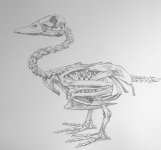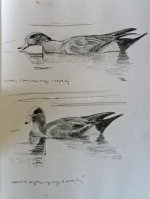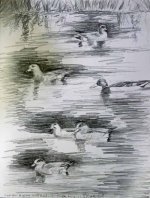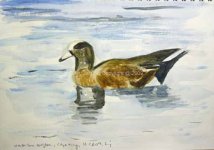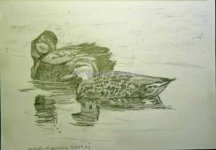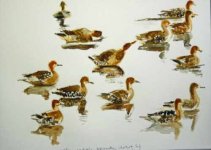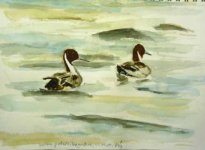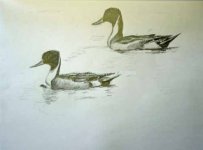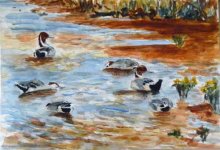-
Welcome to BirdForum, the internet's largest birding community with thousands of members from all over the world. The forums are dedicated to wild birds, birding, binoculars and equipment and all that goes with it.
Please register for an account to take part in the discussions in the forum, post your pictures in the gallery and more.
You are using an out of date browser. It may not display this or other websites correctly.
You should upgrade or use an alternative browser.
You should upgrade or use an alternative browser.
revivingKensArt (1 Viewer)
- Thread starter solitaryVSong
- Start date
More options
Who Replied?solitaryVSong
Well-known member
Thanks Tim!
I do have a 10 pound (in weight) book on bird biology that I decided I was going to have to get out and hunt through today. I know that it has some diagrams like this. After I posted this I thought: you know maybe that is where the leg connects to the torso. Thanks so much for saving me the work. And you're right it is surprising!
This morning just as I was waking up I also remembered that Lars Jonsson has a very vivid Northern Shoveler in his 'Birds of Europe' that I should also take a look at. I still get a kick out of it: the bird stares right at you, like he's going to step off the page and bite your hand!
I do have a 10 pound (in weight) book on bird biology that I decided I was going to have to get out and hunt through today. I know that it has some diagrams like this. After I posted this I thought: you know maybe that is where the leg connects to the torso. Thanks so much for saving me the work. And you're right it is surprising!
This morning just as I was waking up I also remembered that Lars Jonsson has a very vivid Northern Shoveler in his 'Birds of Europe' that I should also take a look at. I still get a kick out of it: the bird stares right at you, like he's going to step off the page and bite your hand!
Strandman
Well-known member
I did a couple of 15-minute watercolors at start of week using photos of a Northern Shoveler I took a few months ago. They were a disaster. So today I decided to do some sketches of the NS and other ducks I had some photos of to see if I couldn't get a better since of duck structure.
After two watercolors and one sketch of the same photo of the NS it finally hit me that I have no idea how he got his foot up in the air like that. I mean I know he got it there by lifting up his leg. But I can't imagine that the leg is attached that high up on the torso. So I'm sure missing something here. I guess this shows the dangers of working from photos. But it was all I had to work with...........
you've got it right- leg is anchored high and far back on all birds (have a look when you next cook a chicken), with a hidden "knee " joint, so all sorts of scope for the foot to appear from unexpected places
PWG
Well-known member
Some while back we had several threads about bird anatomy and you may be interested in this site: http://www.skullsite.com/skeletons/index.htm?birdskeletons.htm~tree
solitaryVSong
Well-known member
Thanks Ed and PWG,
Those skeletons are great! It was late when I posted last night and I thought 'well the leg should be down there where the other one is.' It was only when I woke up this morning that I realized the other one probably started much higher up as well.
I did know that they started a bit higher than you'd think on a bird but still couldn't visualize it up that high. I'm going to need to book mark this skeleton link for the next time I have such questions.
Those skeletons are great! It was late when I posted last night and I thought 'well the leg should be down there where the other one is.' It was only when I woke up this morning that I realized the other one probably started much higher up as well.
I did know that they started a bit higher than you'd think on a bird but still couldn't visualize it up that high. I'm going to need to book mark this skeleton link for the next time I have such questions.
solitaryVSong
Well-known member
A few more duck studies, all based on photos I took. Two sketches are of American Wigeons, including a lone Mallard, and one sketch of two Gadwalls, the male squished just a bit. Finally a quick watercolor of another Wigeon.
I'm slowly working my way through most of the duck photos I've taken over the last year and will probably do a number of additional pencil studies and some quick watercolors.
Then maybe onto a more developed watercolor of ducks, or maybe a more developed pastel or charcoal. I'm starting to get antsy about not touching the charcoal and pastel in such a long time.
I'm slowly working my way through most of the duck photos I've taken over the last year and will probably do a number of additional pencil studies and some quick watercolors.
Then maybe onto a more developed watercolor of ducks, or maybe a more developed pastel or charcoal. I'm starting to get antsy about not touching the charcoal and pastel in such a long time.
Attachments
timwootton
Well-known member
Lovely pencil work Ken - very appealing indeed.
ARTHUR BISHOP
Well-known member
love these Ken
solitaryVSong
Well-known member
Thanks for the comments all! I've been having a good time doing such 'easy' art, just drawing what I see in my duck photos. One of these days I hope it pays off with knowledge gained and that this shows up in more developed work. My guess is that as soon as I start a new watercolor, pastel, charcoal I'll forget all I've learned Well not really but it might look that way.
Well not really but it might look that way.
solitaryVSong
Well-known member
Finished off one more pencil drawing of Northern Pintails today then threw off the bonds of detail and spent some time on some 15-60 minute watercolors, also of Pintails.
Attachments
timwootton
Well-known member
yes.
Woody
Well-known member
ooh, now these are very enjoyable indeedy - lots of mood and atmosphere.
Especially the first one methinks.
Mike
solitaryVSong
Well-known member
ooh, now these are very enjoyable indeedy - lots of mood and atmosphere.
Thanks Nick et al.. I agree eith Mike about the first one being my favorite by far. I find that often if I just start painting without using a pencil I'm happiest with the results.
Knowing that I went and did the opposite on the current, horribly overworked watercolor. Those thin lines of white on the necks of the Pintails I was afraid I'd lose if I didn't pencil them in first. I'm doing these 'quick' watercolors on paper from Aquabee Super Deluxe sketchbook. It's very good. Pretty think and heavy paper and able to take quite a lot of work. But nothing like what I've done here. The paper is warped silly!
But once I got started on it I just couldn't stop. I do like the overall feel of it. But I think it would probably work best as a brand new watercolor on heavier paper.
Attachments
ChrissyM
Well-known member
Hi Ken, that last one is very nice and fluid. You have been busy....
I can never work on thin paper no matter how hard I try for various reasons that I think I shall just shut up about ;-)
As for the Pintails, I like the first one for the reflections and the busier composition, it looks more natural somehow.
I can never work on thin paper no matter how hard I try for various reasons that I think I shall just shut up about ;-)
As for the Pintails, I like the first one for the reflections and the busier composition, it looks more natural somehow.
Similar threads
- Replies
- 8
- Views
- 772
Users who are viewing this thread
Total: 2 (members: 0, guests: 2)




